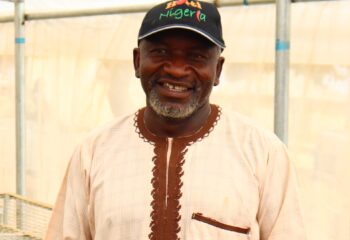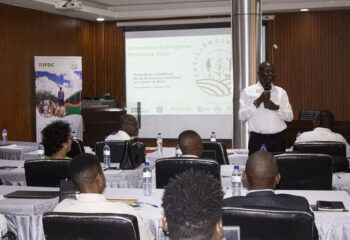Be on the lookout for our upcoming IFDC Magazine, due out at the end of this month. Until then, enjoy one of several success stories included in the next issue.
For years, Pinto Mofate sold charcoal to supplement the low yields he received from his maize plots. Farming simply could not pay all the bills, much less put enough food on the table for his family of 12. Mofate realized it was time to change the way he farmed.
During the 2014-15 cropping season, Mofate offered to host a demonstration plot for the Agricultural Input Market Strengthening (AIMS) III project. He and 10 other farmers set up 300 m2 plots that AIMS III used to highlight the benefits of improved seed varieties and proper land preparation, herbicide application, plant spacing and fertilizer application – all part of a strategy called good agricultural practices (GAP).
Being an innovative farmer, Mofate planted the extra seed in a larger plot just to see for himself if the methods actually worked. Without the help of project staff, he followed what he had been taught. “I used pieces of string to make straight lines in the field, measured the row distance in the plot set up by the staff and used the exact same measurements,” he said.
Mofate tended the fields throughout the season, hoping each day the extra work and new techniques would pay off with high yields. When harvest time came, Mofate could not believe his eyes. Using traditional practices, his yields were often low, at about 500 kilograms (kg)/ha. But with GAP, Mofate now harvests an average of 1.5 tons/ha – six times more than before.
“My first experience [using GAP] was really good,” says Mofate. “I harvested 250 kilograms of maize from my own experimental GAP plot. When you come back next season, you will see my entire field planted in lines. No more traditional practices.”
When harvest time came, Mofate could not believe his eyes. Using traditional practices, his yields were often low, at about 500 kilograms (kg)/hectare (ha). But with the new methods, Mofate now harvests an average of 1.5 tons/ha – six times more than before. “My first experience [using the practices] was really good,” says Mofate. “I harvested 250 kilograms of maize from my own experimental plot. When you come back next season, you will see my entire field planted in lines. No more traditional practices.”
Stories like Mofate’s are common in the AIMS III project area. Improved skills and technologies are empowering farmers in Mozambique. These men and women will be the driving force for increased agricultural gross domestic product (GDP) and food security in the country. Funded by the United States Agency for International Development (USAID), AIMS III concluded in July 2015.



